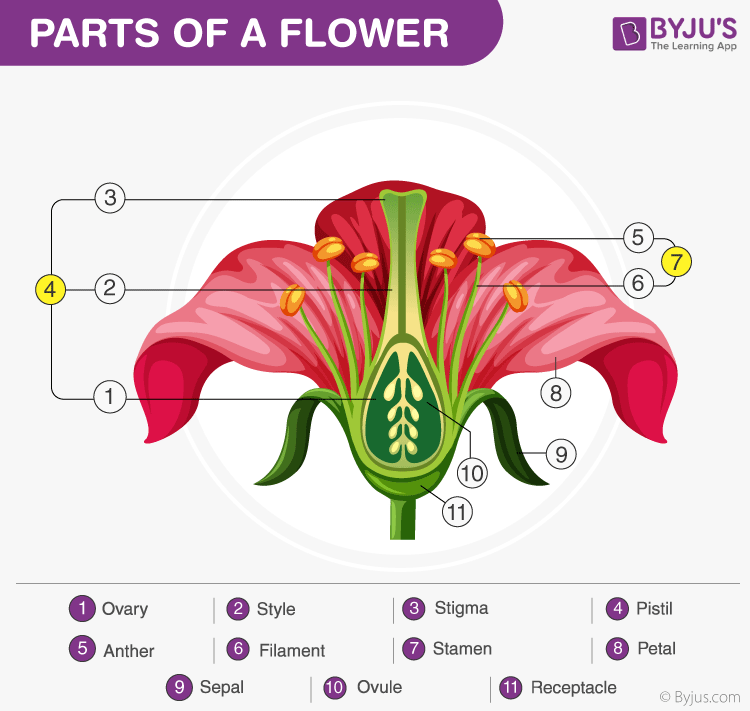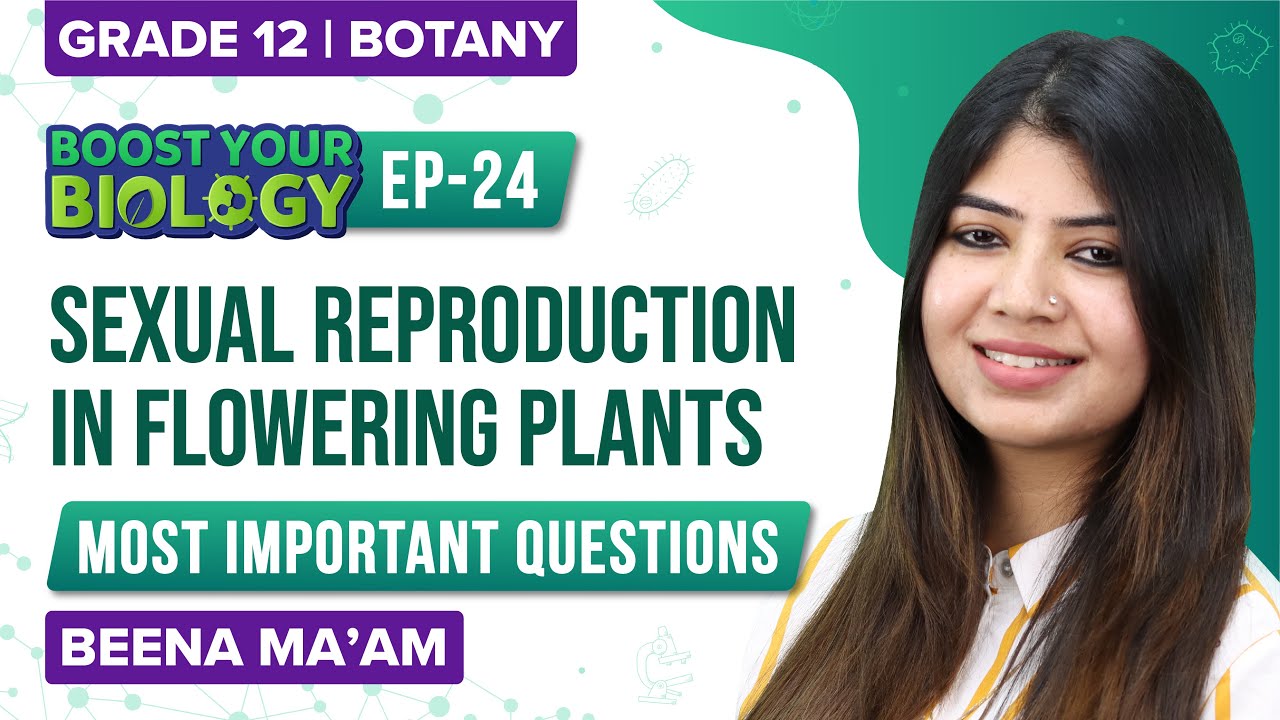Table of Contents

About Flower
Flowers are introduced as the reproductive part of a plant. They are not only involved in reproduction but are also a source of food for other living organisms. They are a rich source of nectar.
Flowers can either be
- Complete
- Incomplete.
A complete flower is one that consists of sepals, petals, stamens and pistils. On the contrary, an incomplete flower is one that lacks one or more of these structures.
A complete flower consists of two different parts:
- Vegetative Part
- Reproductive Part
Also read: Flowers and Inflorescence
Let us have a detailed look at the different parts of a flower.
Flower – Labelled Diagram
Below is a well labelled and simple diagram of a flower for your better understanding.

Parts of a Flower
Parts of a Flower
The calyx, corolla, androecium, and gynoecium are four whorls of modified leaves that constitute the flower. The sepals, petals, stamens, and pistils, respectively, constitute one of the flower parts in each of these whorls.
The different parts of a flower are mentioned below:
Vegetative Parts of a Flower
The vegetative part of a flower consists of the following:
- Petals: This is a bright-coloured part that attracts bees, insects, and birds. The colour of petals varies from plant to plant; some are bright while some are pale coloured. Thus, petals help us to differentiate one flower from another.
- Sepals: Sepal is the green-coloured part beneath the petals to protect rising buds. Some flowers have fused petals-sepals while a few have separated petals-sepals.
Reproductive Parts of a Flower
Flowers contain the plant’s reproductive structures.
In different plants, the number of petals, sepals, stamens and pistils can vary. The presence of these parts differentiates the flower into complete or incomplete. Apart from these parts, a flower includes reproductive parts – the stamen and pistil. A flower may have only female parts, only male parts, or both.
The reproductive parts of a flower consist of the following:
- Stamen: This is the male reproductive organ and is also known as Androecium. It consists of two parts namely: anther and filaments.
- The anther is a yellowish, sac-like structure, involved in producing and storing the pollens.
- The filament is a slender, threadlike object, which functions by supporting the anther.
- Pistil: This is the innermost part and the female reproductive organ of a flower which comprises three parts -stigma, style and ovary. This is collectively known as the pistil.
- Stigma: It is the topmost part or receptive tip of carpels in the gynoecium of a flower.
- Style: It is the long tube-like slender stalk that connects the stigma and the ovary.
- Ovary: It is the ductless reproductive gland that holds a lot of ovules. It is the part of the plant where the seed formation takes place.
Also Read: Artificial Hybridization in Plants
Whorls
Along with the vegetative and reproductive parts, a flower is also composed of four whorls, which are largely responsible for the radial arrangement of a flower. A typical flower has a circular section with a common centre, which can be clearly observed and distinguished from the top of the flower. There four whorls are:
Calyx
The calyx is the outermost whorl of a flower. It comprises sepals, and tiny leaves present at the base of a flower. These protect the flower whorls against mechanical injuries and desiccation. Some plants have coloured sepals the calyx and are called petaloid.
If the sepals are free the calyx is called polysepalous, and if they are united it is called gamosepalous.
In many flowers, the sepals fall off before the flower even opens fully. Such sepals are known as caducous.
In some, the sepals fall off after fertilization. Such sepals are known as deciduous.
The persistent sepals remain up to the fruiting stage.
Corolla
This is the second whorl of a flower. It contains petals which serve two main functions:
- To attract pollinators.
- To protect the reproductive parts of a flower
Petals are brightly coloured and scented to attract animals and insects for pollination. The calyx and corolla are collectively called the perianth.
Different forms of the corolla are found in the flowers.
- Polypetalous Regular
- Polypetalous Irregular
- Gamopetalous Regular
- Gamopetalous Irregular
Stamens
Stamen is also known as the third whorl of the flower and is the male reproductive part. It consists of a filament which is a thread-like structure with a circular structure anther on the top. Pollen is produced by the anther which contributes to the male reproductive process of the plant. All the stamens do not bear fertile anthers.
Carpels
The carpel is the fourth whorl of the flower present in the centre. The carpels contain the pistil, the female reproductive part of the flower. It comprises the ovary, style, and stigma. The egg or the ovule is present in the ovary. After fertilization, sometimes the ovary turns into the fruit to keep the seed. At the top of the ovary is a vertical structure called style that supports the stigma. The dispersed pollens stick to the stigma and travel down to the ovary through the style.
This was an overview of the different parts of a flower.
Also Read: Sexual Reproduction in Flowering Plants
Functions of a Flower
The important functions of flowers are mentioned below:
- Gametophytes develop in the flowers.
- The flowers can produce diaspores without fertilization.
- After fertilization, the ovary of the flower develops into a fruit containing a seed.
- The most important function of flowers is reproduction. They help in the union of male and female gametes.
- Flowers provide nectar to certain birds and insects, which in turn help in the transfer of pollen from one flower to the other.
- Flowers may promote selfing, i.e., the union of sperms and eggs from the same flower, or cross-fertilization, i.e., the union of sperms and eggs from different flowers.
Also read: Flowers and Inflorescence
Pollination
Pollination is the process in which the pollens are transferred from anther to stigma. The process of pollination can occur through a different medium.
The table mentioned below describes the different types of pollination along with their pollinating agents.
| Pollination Process | Pollination Medium |
| Malacophilous | By snails |
| Chiropteriphilous | By bats |
| Hydrophilous | By water |
| Zoophilous | By animals |
| Anemophilous | By air |
| Entomophilous | By insects |
| Ornithophilous | By birds |
Also Read: What is Pollination
For more detailed information on parts of a flower, its functions and its importance, explore at BYJU’S Biology.
Frequently Asked Questions
What are the important parts of a flower?
The important parts of a flower include:
- Sepals
- Petals
- Stamens
- Pistil
How do flowers reproduce?
Flowers reproduce by a process called pollination. In this process, the male gametes are transferred to the female ovules where fertilization occurs and ovules grow into seeds within a fruit.
Give 10 uses of flowers.
History demonstrates that people have been using flowers for various reasons for thousands of years. Ten uses of flowers include:
- Production of food
- Origin of honey
- Origin of medicine
- Promote crop production and pollination
- Enhance the neighbouring area
- Provide fragrances and colognes
- Decoration
- Preparation of dyes
- Pest deterrents
- Promote breeding
What are the reproductive parts of a flower?
Stamen is the male reproductive part of a flower, while pistil is the female reproductive part of a flower. The stamen is surrounded by anther and filament. The anthers produce pollen grains.


Very good explanation!!
Could understand everything easily and useful for last minute studies 😋
East or West byjus is best
So good for understand of students
It was very helpful.
I Understand very easily bcoz language are very simple
Thank you so much.
It is effective and I am proud to watch the video
I like your speaking skills
I could understand perfectly.
It is a remarkable answer. Thank you, Byju’s.
Do not take rest, Byju’s is the best. Come fall with 💖learning.
Thank you ❤️😊 this helps so much ❤️💕💗
Helps a lot
It helps a lot, thanks
It helps a lot, Thanks
Superb explanation I could understand better 💕
this is the best way of learing. I love it
My favorite mobile application😍😍😍🤗